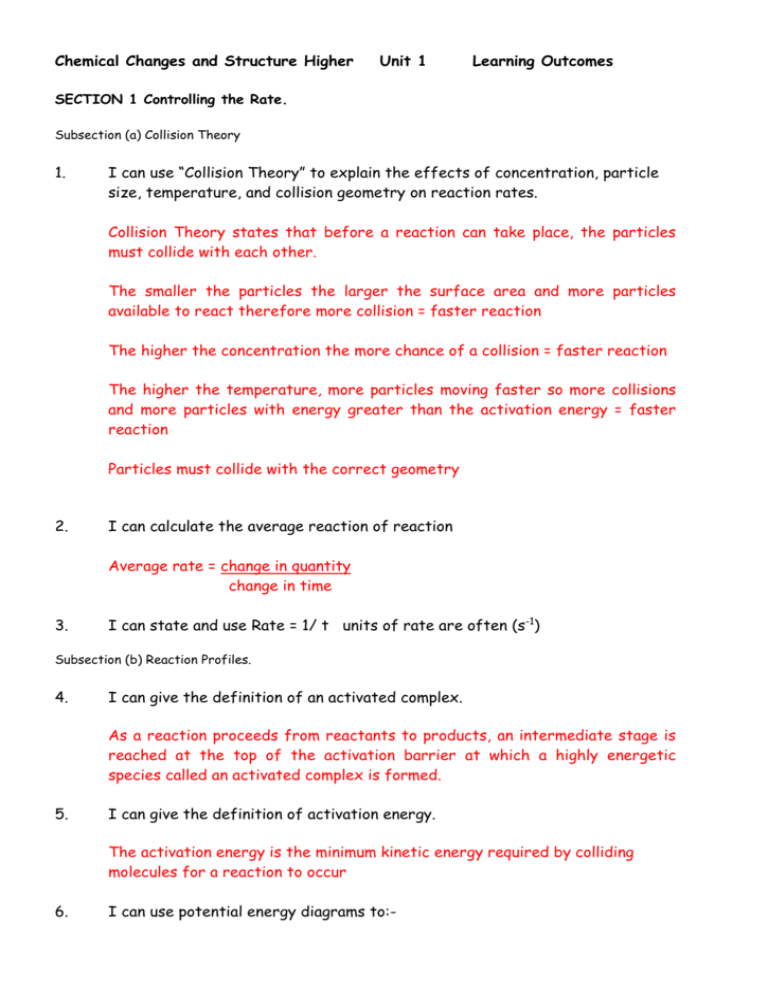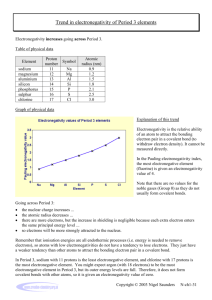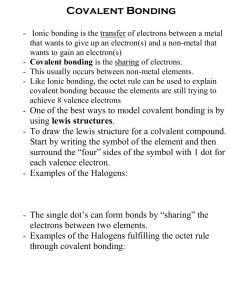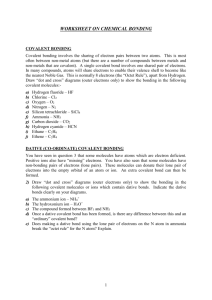Periodicity, Polarity and Properties
advertisement

Chemical Changes and Structure Higher Unit 1 Learning Outcomes SECTION 1 Controlling the Rate. Subsection (a) Collision Theory 1. I can use “Collision Theory” to explain the effects of concentration, particle size, temperature, and collision geometry on reaction rates. Collision Theory states that before a reaction can take place, the particles must collide with each other. The smaller the particles the larger the surface area and more particles available to react therefore more collision = faster reaction The higher the concentration the more chance of a collision = faster reaction The higher the temperature, more particles moving faster so more collisions and more particles with energy greater than the activation energy = faster reaction Particles must collide with the correct geometry 2. I can calculate the average reaction of reaction Average rate = change in quantity change in time 3. I can state and use Rate = 1/ t units of rate are often (s-1) Subsection (b) Reaction Profiles. 4. I can give the definition of an activated complex. As a reaction proceeds from reactants to products, an intermediate stage is reached at the top of the activation barrier at which a highly energetic species called an activated complex is formed. 5. I can give the definition of activation energy. The activation energy is the minimum kinetic energy required by colliding molecules for a reaction to occur 6. I can use potential energy diagrams to:- o say if a reaction is exothermic or endothermic. Exothermic reactions give out energy to the surroundings. In an exothermic reaction, the products have less energy than the reactants. In an endothermic reaction, the products have more energy than the reactants. Endothermic reactions take in energy from the surroundings. o calculate the enthalpy change for a reaction with the correct units and sign. ∆H is negative for an exothermic reaction. The unit is kJmol-1 ∆H is positive for an endothermic reaction. The unit is kJmol-1 o calculate the activation energy needed for forward, reverse and catalysed reactions. In the potential energy diagrams the activation energy is the ‘energy barrier’ which reactants must get over to become products. 7. I can explain why it is essential that chemists can predict the quantity of heat taken in or given out in an industrial process. Runaway reactions such as those causing the disasters in Bhopal and Seveso occur when the rate at which a chemical reaction releases energy exceeds the capabilities of the plant to remove heat. Endothermic reactions require heating this results in higher energy costs. Subsection (c) Temperature and kinetic energy. 8. I can give the definition of temperature. Temperature is a measure of the average kinetic energy of the particles in a chemical. 9. I can use energy distribution diagrams to explain the effect of temperature on reaction rate. The activation energy is the minimum energy that particles need to collide successfully. Only particles with energy above this level have the potential to react. At a higher temperature more particles have energy greater than the activation energy so faster reaction occur. Subsection (d) Catalysts. 10. I can state how catalysts affect the activation energy for a chemical reaction. Catalysts lower the activation energy for a reaction, making it easier to form the activated complex. 11. Draw a potential energy diagram to show the effect of a catalyst on the activation energy. Enthalpy reactant and products unchanged Hump should be lowered to show the activation energy is lowered Section 2 Trends in the Periodic Table and Bonding Subsection (a) The Arrangement of Elements in the Periodic Table. 12. I can describe the connection between atomic number and the order of elements in the Periodic Table. Elements are arranged in order of increasing atomic number. 13. I can predict the properties of an element using its position in the Periodic Table. Group 1 reactive. Reactivity increases down the group. Group 7 reactive. Reactivity decreases down the group. 14. Group 0 unreactive. I can identify periods in the Periodic Table. Rows are periods. 15. I can identify groups in the Periodic Table. Columns are groups. 16. I can explain why certain elements have similar properties. Elements with the same number of outer electrons have similar properties. 17. I can describe the relationship between the number of outer electrons and group. The number of outer electrons is the same as the group number. 18. I can describe the change in the number of outer electrons across a period. The number of outer electrons increases as you go across a period. 19. I can identify the position of metals and non–metals in the Periodic Table. Metals are at the left hand side of the Periodic Table while non-metals are at the right hand side. 20. I can describe the move from metallic to non-metallic characteristics. Metallic characteristics decrease as you go across a period. Subsection (b) Bonding and Structure of the first twenty Elements 23. I can explain how a covalent bond is formed. A covalent bond is a pair of shared electrons. 24. I can describe the behaviour of outer electrons in metallic bonding. In metals the outer electrons are delocalised. 25. I can explain the difference between covalent network and covalent molecular. Covalent molecular elements or compounds have a definite number of atoms bonded together. Covalent network elements or compounds have a vast but indefinite number of atoms bonded together. 26. I can give examples of metallic, covalent molecular, covalent network and monatomic elements. Metallic elements are at the left hand side of the Periodic Table. N2, O2, F2, Cl2, Br2, I2, P4, S8, H2 and fullerenes such as C60 (fullerene) are covalent molecular. Si and C in the form of diamond and graphite are covalent network. The noble gases He, Ne, Ar Kr, Xe, Rn are monatomic. Subsection (c) Periodic Trends in Ionisation Energies and Covalent radii 27. I can use covalent radius to describe the changes in the size of atoms across a period and down a group. The covalent radius is a measure of the size of an atom. Atoms get bigger as you go down a group and smaller as you go across a period. 28. I can explain the change in covalent radius in terms of changes in the number of occupied shells or the nuclear charge. As you go across a period the nucleus becomes more positive so the shells of electrons are more strongly attracted to the nucleus. This makes the atoms smaller. As you go down a group there is another shell of electrons. This makes the atoms larger. 29. I can state what is meant by first, second and third ionisation energies. The first ionisation energy is the energy required to remove one mole of electrons from one mole of atoms in the gaseous state. The second and subsequent ionisation energies refer to the energies required to remove further moles of electrons. 30. I can write state equations to represent first, second and third ionisation energies. First Ionisation Energy Second Ionisation Energy Third Ionisation Energy 31. E(g) E+ (g) + eE+(g) E2+(g) + eE2+(g) E3+(g) + e- I can use atomic size and screening effect to explain the change in ionisation energies down a group. As you go down a group the atoms are bigger as there is another shell of electrons. The outer electrons are further from the nucleus and are also shielded from the full effect of the nucleus by the inner electrons. The outer electron is easier to remove so the ionisation energy decreases. 32. I can use atomic size and nuclear charge to explain the change in ionisation energies across a period. As you go across a period the positive charge on the nucleus increases making the atoms smaller. The outer electrons are closer to the nucleus so more strongly attracted. The outer electron is more difficult to remove so the ionisation energy increases. Subsection (d) Periodic Trends in Electronegativity 33. I can explain the effect of electronegativity on electrons in a covalent bond. The higher the electronegativity the stronger the attraction of the atom for the shared electrons in a covalent bond. 34. I can describe, using a data book, the change in electronegativity down a group. Electronegativity decreases as you go down a group. Electronegativity increases as you go along a period. 35. I can use atomic size and nuclear charge to explain the change in electronegativity across a period. As atoms get smaller the bonding electrons are closer to the positive nucleus so are more strongly attracted. The electronegativity increases. 36. I can use atomic size and screening effect to explain the change in electronegativity down a group. As the atoms get larger the bonding electrons are further from the nucleus and are also screened from the full effect of the nucleus by the inner electrons. The electronegativity decreases. Subsection (e) Polar Covalent Bonds 37. I can describe a covalent bond in terms of electrons and positive nuclei. The atoms in a covalent bond are held together because the two positive nuclei are both attracted to the same pair of shared electrons. 38. I can use electronegativity values to distinguish between pure covalent and polar covalent bonds. In pure covalent bonds the atoms have the same or very similar electonegativities so share electrons equally. In polar covalent bonds the atoms have different electonegativities so the bonding electrons are shared unequally. 39. I can use the data book to assign + and - partial charges on atoms. The atom with the higher electronegativity will have a greater share of the bonding electrons so will have a - charge. The atom with the lower electronegativity will have a + charge. 40. I can distinguish between bonds which show a dipole and those that are nonpolar. + and - show partial charges on atoms in a polar covalent bond. This is called a dipole. Subsection (f) Bonding Continuum 41. I can explain the relationship between differences in electronegativity and type of bonding. Ionic and pure covalent bonding are opposite extremes with polar covalent bonding in e middle, A very large difference in electronegativity leads to ionic bonding. A small difference in electronegativity leads to polar covalent bonding. Atoms with the same electronegativity have pure covalent bonds. 42. I can use data from properties such as conductivity, melting point and boiling point to deduce type of bonding and structure. High melting point and boiling point = ionic or covalent network Low melting point and boiling point = covalent molecular Non-conductor = covalent molecular or covalent network Conductor when molten or dissolved but not when solid = ionic 43. I can list exceptions to the statements: “Compounds formed between nonmetals only are covalent. Compounds formed between a metal and a non-metal are ionic”. Acids are ionic (HCl, H2SO4, HNO3) Some metals can sometimes form covalent compounds (SnI4, TiCl4) Section 3 Intermolecular forces Subsection (a) Van der Waal’s Forces 44. I can explain the difference between intermolecular and intramolecular forces. Intramolecular forces hold atoms together to form a molecule - polar covalent bonds and pure covalent bonds. Intermolecular forces are forces of attraction between molecules – Van der Waal’s forces. 45. I can name temporary and permanent Van der Waal’s forces. Temporary – London dispersion forces Permanent – permanent dipole to permanent dipole attractions such as hydrogen bonding 46. I can give examples of compounds with temporary and permanent Van der Waal’s forces. London dispersion forces are temporary and exist between all atoms and molecules. Compounds with N, O or F directly bonded to H have hydrogen bonding between molecules. Hydrogen bonding is an example of a permanent dipole to permanent dipole attraction. Subsection (b) London Dispersion Forces 47. I can explain how London dispersion forces arise. A temporary uneven distribution of electrons within atoms and molecules. 48. I can state where London dispersion forces arise. Between atoms and all molecules. 49. I can relate the strength of London dispersion forces to the number of electrons within the atom or molecule. The greater the number of electrons the stronger the London dispersion forces. 50. I can relate London dispersion forces to other types of bonds in terms of strength. London dispersion forces are very weak – weaker than all other types of bonding. Subsection (c) Permanent Dipole-Permanent Dipole Interactions 51. I can explain how permanent dipole-permanent dipole interactions arise. An atom in one molecule with a partial positive charge smaller electronegativity (+) attracts an atom in a neighbouring molecule with a partial negative charge larger electronegativity (-). 52. I can use spatial arrangement of polar covalent bonds to predict whether a molecule is polar or non-polar. If the positive centre coincides with the negative centre the molecule is nonpolar. eg tetrahedral - CCl4 If the positive and negative centre do not coincide the molecule is polar. eg tetrahedral CHCl3 , bent H2O 53. I can relate permanent dipole-permanent dipole interactions to other types of bonds in terms of strength. Permanent dipole – permanent dipole interactions are weak but stronger than London dispersion forces. Ionic and covalent bonds > permanent dipole–permanent dipole > London dispersion forces Subsection (d) Hydrogen Bonding 54. I can correctly describe hydrogen bonding as an example of intermolecular or intramolecular bonding. Hydrogen bonding is an example of a permanent dipole – permanent dipole attraction. It is intermolecular – between molecules. 55. I can identify from the structural formula or the molecular formula compounds which have hydrogen bonds. Molecules with N, O or F directly bonded to H will have hydrogen bonding between molecules. 56. I can relate hydrogen bonding to other types of bonds in terms of strength. Hydrogen bonding is weak but is stronger than other examples of permanent dipole- permanent dipole attractions. Ionic and covalent bonds > hydrogen bonding > other permanent dipole– permanent dipole attractions > London dispersion forces Subsection (e) Relating Properties to Intermolecular Forces 57. I can explain the relationship between the type and strength of intermolecular bonds and melting point, boiling point and viscosity. Covalent compounds with hydrogen bonding between molecules have higher melting points, boiling points and viscosity than those with only London dispersion forces. 58. I can predict the strength of intermolecular forces by considering the polarity of molecules and the number of electrons. Polar molecules will have stronger intermolecular forces than non-polar molecules. The greater the number of electrons the stronger the London dispersion forces between molecules. 59. I can explain patterns in melting and boiling points in terms of the strength of intermolecular forces. The higher the melting point and boiling point the stronger the intermolecular forces. 60. I can explain why the boiling points of ammonia, water and hydrogen fluoride are higher than expected given the number of electrons present in the molecules. NH3, H2O and HF have hydrogen bonding between their molecules. 61. I can explain how hydrogen bonding affects boiling points, melting points, viscosity and solubility (miscibility). Hydrogen bonding increases melting points, boiling points and viscosity compared to those with only London dispersion forces. Hydrogen bonding between the molecules and water molecules makes the substance soluble or miscible with water. 62. I can explain why ice is less dense than water. Hydrogen bonding between water molecules gives ice an open structure. The density of ice is lower than that of liquid water unlike other chemicals where the solid is more dense than the liquid. Subsection (f) Predicting solubility from solute and solvent polarities 63. I can state the type of solvent which tends to dissolve ionic compounds and polar molecular compounds. Like dissolves like. Polar solvents tend to dissolve ionic compounds and covalent compounds with polar molecules. Water is a polar solvent. 64. I can state the type of solvent which tends to dissolve non-polar molecular compounds. Like dissolves like. Non-polar solvents tend to dissolve covalent compounds with non-polar molecules. 65. I can select groups within molecules which imply hydrogen bonding. Molecules with O-H and N-H groups have hydrogen bonding between molecules. The O- or N- in one molecule attracts the H+ in another. 66. I can identify molecules with a permanent dipole by considering the spatial arrangement of polar covalent bonds. If the positive and negative centres coincide the molecule is non-polar. If the positive and negative centres do not coincide the molecule is polar. Section 4 The mole Subsection (a) calculation of the mass. 67. I am able to use balanced equations to work out mole ratios of reactants and products. 68. I can use balanced equations and formula mass to work out the mass of product from reactant and vice versa. Subsection (b) molar volume 69. I can calculate the volume of a gas from the number of moles and vice versa. Give the units for molar volume. litres mol -1 70. I know that molar volume is the same for ALL gases at the same temperature and pressure. The volume taken up by 1 mole of a gas is called the molar volume. The value of the molar gas volume is approx 22.4 litres mol -1 depending on the temperature and pressure of the environment. 71. I can calculate the volumes of reactant and product gases from the number of moles of each reactant and product. Subsection (c) Calculations in reactions that involve solutions. 72. I can give the units for concentration mol l-1 Subsection (d) Excess 73. I understand what is meant by “atom economy”. The atom economy measures the proportion of the total mass of all starting materials successfully converted into the desired product. 74. I can calculate the atom economy of a reaction using the correct formula. Atom economy = mass of desired products x 100 Total mass of reactants Subsection (e) Excess. 75. I can explain and identify the excess reactant(s). The reaction will be over once one of the reactants has been used up – the other one is said to be ‘in excess’. 76. I can relate cost to excess reactant(s) used in industrial processes. In order to minimise costs, industry aims to have the cheaper reactant in excess where possible. 77. I can use a balanced equation to work out the reactant in excess and therefore the limiting reactant, for a chemical reaction. 78. I can relate excess reactant(s), percentage yields and atom economy to the idea of an economic/environmental balance in industrial processes. Subsection (f) Atom economy 79. I undertand what is meant by the term atom “economy”. The atom economy measures the proportion of total mass of all starting materials successfully converted into the desired product. 80. I can calculate the atom economy of a reaction using the correct formula. Atom economy = Mass of desired products X 100 Total mass of reactants 81. I understand why some reactions that have a high percentage yield may have a low atom economy. (see unit 2 for % yield) High % yield and low atom economy means a lot of waste products are being produced 82. I can relate % yield and atom economy to different routes taken in manufacturing products. Industrial process want efficiency i.e. high percentage yield and high atom economy.







